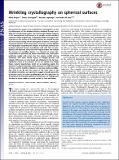Wrinkling crystallography on spherical surfaces
Author(s)
Brojan, Miha; Terwagne, Denis; Lagrange, Romain; Reis, Pedro Miguel
DownloadBrojan-2015-Wrinkling crystallog.pdf (1.577Mb)
PUBLISHER_POLICY
Publisher Policy
Article is made available in accordance with the publisher's policy and may be subject to US copyright law. Please refer to the publisher's site for terms of use.
Terms of use
Metadata
Show full item recordAbstract
We present the results of an experimental investigation on the crystallography of the dimpled patterns obtained through wrinkling of a curved elastic system. Our macroscopic samples comprise a thin hemispherical shell bound to an equally curved compliant substrate. Under compression, a crystalline pattern of dimples self-organizes on the surface of the shell. Stresses are relaxed by both out-of-surface buckling and the emergence of defects in the quasi-hexagonal pattern. Three-dimensional scanning is used to digitize the topography. Regarding the dimples as point-like packing units produces spherical Voronoi tessellations with cells that are polydisperse and distorted, away from their regular shapes. We analyze the structure of crystalline defects, as a function of system size. Disclinations are observed and, above a threshold value, dislocations proliferate rapidly with system size. Our samples exhibit striking similarities with other curved crystals of charged particles and colloids. Differences are also found and attributed to the far-from-equilibrium nature of our patterns due to the random and initially frozen material imperfections which act as nucleation points, the presence of a physical boundary which represents an additional source of stress, and the inability of dimples to rearrange during crystallization. Even if we do not have access to the exact form of the interdimple interaction, our experiments suggest a broader generality of previous results of curved crystallography and their robustness on the details of the interaction potential. Furthermore, our findings open the door to future studies on curved crystals far from equilibrium.
Date issued
2015-01Department
Massachusetts Institute of Technology. Department of Civil and Environmental Engineering; Massachusetts Institute of Technology. Department of Mathematics; Massachusetts Institute of Technology. Department of Mechanical EngineeringJournal
Proceedings of the National Academy of Sciences
Publisher
National Academy of Sciences (U.S.)
Citation
Brojan, Miha, Denis Terwagne, Romain Lagrange, and Pedro M. Reis. “Wrinkling Crystallography on Spherical Surfaces.” Proc Natl Acad Sci USA 112, no. 1 (December 22, 2014): 14–19.
Version: Final published version
ISSN
0027-8424
1091-6490